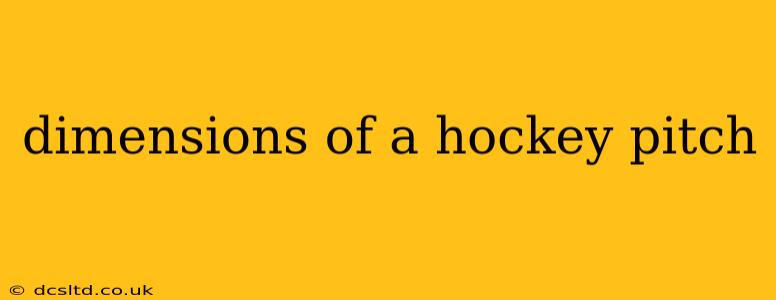Dimensions of a Hockey Pitch: A Comprehensive Guide
The dimensions of a hockey pitch aren't standardized across all levels of play, leading to some confusion. This guide will break down the variations, clarifying the specifics for different competitions and explaining the reasoning behind the size differences. Understanding these dimensions is crucial for players, coaches, and referees alike.
What are the standard dimensions of a hockey pitch?
The official dimensions of a hockey pitch, as defined by the International Hockey Federation (FIH), vary depending on the level of competition. Generally, there's a range, but the most commonly used dimensions are:
- Length: 91.4 meters (100 yards)
- Width: 55 meters (60 yards)
These dimensions apply to international matches and top-level professional leagues. However, it's vital to remember this is the maximum size. Youth leagues and smaller competitions often utilize smaller pitches to suit the age and skill level of the players.
What are the dimensions of a hockey pitch for different age groups?
The FIH provides guidelines for pitch dimensions that scale down for younger players. These smaller pitches help to maintain a fast-paced game appropriate to their skill level and physical capabilities. Specific dimensions vary depending on the age group, and local governing bodies might have slightly different specifications. It’s always best to consult the rules and regulations of the specific league or competition.
Are there any variations in hockey pitch dimensions?
Yes, there can be variations. While the FIH's recommendations provide a framework, some leagues or organizations may have slightly different preferences. These variations are generally minor and often dictated by the available space or local regulations.
How do the dimensions of a hockey pitch impact gameplay?
The size of the pitch significantly impacts gameplay. A larger pitch demands greater endurance and strategic thinking from players, prioritizing long passes and more open play. A smaller pitch encourages quicker transitions and closer marking, emphasizing individual skill and agility.
What is the size of a hockey goal?
Regardless of the pitch size, the dimensions of the hockey goal remain consistent:
- Height: 2.14 meters (7 feet)
- Width: 3.66 meters (12 feet)
Why are there different sizes of hockey pitches?
The variation in pitch size caters to different levels of competition and player development. Smaller pitches are better suited for younger and less experienced players, allowing for more frequent touches and opportunities to learn the game. As players progress, they transition to larger pitches, developing their strategic thinking, endurance, and longer-range passing skills. Essentially, the pitch size scales with the player's experience and ability.
Where can I find the exact dimensions for a specific hockey league?
The best place to find precise dimensions is through the official rulebook or regulations of the specific league or tournament you are interested in. Check their website or contact their governing body directly for the most accurate and up-to-date information.
By understanding the nuances in hockey pitch dimensions, you gain a deeper appreciation for the tactical and strategic aspects of the game, regardless of the level of play. Remember to always check the specific regulations for the competition in question to ensure you're working with the correct measurements.
